Integral PWR-Type Small Modular Reactor Developmental Status, Design Characteristics and Passive Features: A Review
Abstract
1. Introduction
2. iPWR-Type Small Modular Reactor Designs
2.1. ACP100
| iPWR Designs | CAREM | SMART | NuScale | ACP100 | mPower | CAP150 | IRIS | IMR | W-SMR | VBER-300 | RITM-200 |
|---|---|---|---|---|---|---|---|---|---|---|---|
| Major primary system component integration | |||||||||||
| SGs | Yes | Yes | Yes | Yes | Yes | Yes | Yes | Yes | Yes | Yes | Yes |
| Pressurizer | Yes | Yes | Yes | No | Yes | Yes | Yes | Yes | Yes | No | No |
| CRDMs | Yes | No | No | No | Yes | Yes | Yes | Yes | Yes | Yes | No |
| Key design characteristics | |||||||||||
| Approach to ESFs | Passive | Passive | Passive | Passive | Passive | Passive | Passive | Hybrid | Passive | Hybrid | Hybrid |
| PCCM | NC | FC | NC | FC | FC | FC | FC | NC | FC | FC | FC |
| MW(th) | 100 | 365 | 160 | 385 | 575 | 450 | 1000 | 1000 | 800 | 917 | 175 |
| MW(e) | 31 | 100 | 50 | 125 | 195 | 150 | 335 | 350 | 225 | 325 | 50 |
| Predicted CDF (/ry) | |||||||||||
| Modules per plant | 2 | ||||||||||
| Design life (years) | 60 | 60 | 60 | 60 | 60 | 80 | 60 | 60 | 60 | 60 | 60 |
| TCD (months) | 36 | 36 | 36 | 36 | 35 | 36 | 36 | 40 | 48 | ||
| CC | Possible | Yes | Possible | Possible | Possible | Possible | Possible | Yes | Possible | Yes | Yes |
2.2. CAP150
2.3. CAREM25
2.4. IMR
2.5. IRIS
2.6. mPower
2.7. NuScale
2.8. RITM-200
2.9. SMART
2.10. VBER-300
2.11. Westinghouse SMR
3. The Need for Passive Safety Systems
4. Classification of Passive Safety Systems
4.1. Classification by Class
- Category A: characterized by systems that have no signal inputs of intelligence, no external power sources, no moving mechanical parts, and no moving working fluid, e.g., fuel cladding and surge tanks.
- Category B: characterized by systems that have no signal inputs of intelligence, no external power sources or forces, no moving mechanical parts but have a moving working fluid, e.g., passive containment cooling systems based on natural circulation of air flow.
- Category C: characterized by systems that have no signal inputs of intelligence, no external power sources or forces, but composed of moving mechanical parts with or without moving working fluids, e.g., relief and check valves.
- Category D: intermediary zone between active and passive where the execution of safety functions is made through passive methods, i.e., passive execution/active initiation, e.g., emergency shutdown systems based on gravity.
4.2. Classification by Principle of Operation
4.2.1. Gravity Driven Systems
4.2.2. Natural Circulation (NC)
4.3. Classification by Function
4.3.1. Passive Residual Heat Removal System (PRHRS)
4.3.2. Passive Safety Injection System (PSIS)
4.3.3. Passive Depressurization System (PDS)
4.3.4. Passive Containment Cooling System (PCCS)
5. Passive Safety Systems in iPWR-Type SMRs
6. Challenges and Open Issues Related to Passive Safety Systems
7. Conclusions
Author Contributions
Funding
Acknowledgments
Conflicts of Interest
References
- Subki, M.H. Advances in Development and Deployment of Small Modular Reactor Design and Technology. In Proceedings of the ANNuR-IAEA-USNRC Workshop on SMRs Safety and Licensing, Vienna, Austria, 12–15 January 2016. [Google Scholar]
- International Atomic Energy Agency. Innovative Small and Medium Sized Reactors: Design features, Safety Approaches and R&D Trends; TECDOC-1451; IAEA: Vienna, Austria, 2004. [Google Scholar]
- Subki, M.H. Update on International SMR Development and Deployment Activities. In Proceedings of the IAEA Technical Meeting on Roadmap for SMR Deployment, Vienna, Austria, 12 October 2015. [Google Scholar]
- Nuclear Energy Agency. Current Status, Technical Feasibility and Economics of Small Nuclear Reactors; Organisation of Economic Cooperation and Development: Paris, France, 2011. [Google Scholar]
- International Atomic Energy Agency. Deployment Indicators for Small Modular Reactors: Methodology, Analysis of Key Factors and Case Studies; TECDOC-1854; IAEA: Vienna, Austria, 2018. [Google Scholar]
- International Atomic Energy Agency. Advances in Small Modular Reactor Technology Developments; A Supplement to: Advanced Reactors Information System 2018 Edition; IAEA: Vienna, Austria, 2018. [Google Scholar]
- International Atomic Energy Agency. Technical Feasibility and Reliability of Passive Safety Systems for Nuclear Power Plants; TECDOC-920; IAEA: Vienna, Austria, 1994. [Google Scholar]
- Schulz, T. Westinghouse AP1000 advanced passive plant. Nucl. Eng. Des. 2006, 236, 1547–1557. [Google Scholar] [CrossRef]
- General Electric Company. The ESBWR Plant General Design Description; GE Nuclear Energy: Wilmington, NC, USA, 2007. [Google Scholar]
- Mizuno, Y.; Ninokata, H.; Finnicum, D.J. Risk-informed design of IRIS using a level-1 probabilistic risk assessment from its conceptual design phase. Reliab. Eng. Syst. Saf. 2005, 87, 201–209. [Google Scholar] [CrossRef]
- Danrong, S.; Quan, B. Small Modular Nuclear Reactor (SMR) Research and Development (R&D) and Deployment in China. In Proceedings of the ICAPP 2014, Charlotte, NC, USA, 6–9 April 2014; p. 14065. [Google Scholar]
- Hidayatullah, H.; Susyadi, S.; Subki, M.H.; Khan, H. Design and technology development for small modular reactors–Safety expectations, prospects and impediments of their deployment. Prog. Nucl. Energy 2015, 79, 127–135. [Google Scholar] [CrossRef]
- Ingersoll, D.T. An Overview of the Safety Case for Small Modular Reactors. ASME 2011 Small Modular Reactors Symposium 2011, 369–373. [Google Scholar] [CrossRef]
- Zeliang, C. Design Philosophy and Application of Defense-in-Depth Strategy in Integral Pressurized Water Reactor Type Small Modular Reactors; Journal of Nuclear Engineering and Technology: Amsterdam, The Netherlands, 2019. [Google Scholar]
- United State Nuclear Regulatory Commission. Design Certification Application–NuScale, Application Documents. 2020. Available online: https://www.nrc.gov/reactors/new-reactors/design-cert/nuscale.html (accessed on 14 May 2020).
- Mi, Y.; Zeliang, C.; Tokuhiro, A.; Lu, L. A Comparative Assessment of Passive Safety Systems in Integral Pressurized Water Reactor Type Small Modular Reactor. In Proceedings of the 27th International Conference on Nuclear Engineering (ICONE27), Tsukuba, Ibaraki, Japan, 19–24 May 2019. [Google Scholar]
- Qiu, Z.; Zhe, L.; Xiao, C. Design, Technology and Safety features of ACP100 for Near-Term Deployment in China. In Proceedings of the IAEA Reseach Coordination Meeting on “Design and Performance Assessment of Passive Engineered Safety Features in SMRs”; IAEA: Vienna, Austria, 2018. [Google Scholar]
- Zhe, L.; Zhifang, Q.; Xiao, C. Research on Approaches for Schematic Design and Performance Assessment of Passive Engineered Safety Features for ACP100. In Proceedings of the IAEA Reseach Coordination Meeting on “Design and Performance Assessment of Passive Engineered Safety Features in SMRs”; IAEA: Vienna, Austria, 2018. [Google Scholar]
- Danrong, S. Technology Roadmap for ACP100 Deployments. In Proceedings of the IAEA Technical Meeting on “Technology Roadmap for Small Modular Reactor Deployment”; IAEA: Vienna, Austria, 2015. [Google Scholar]
- International Atomic Energy Agency. Advances in Small Modular Reactor Technology Developments-A supplement to: Advanced Reactors Information System; IAEA: Vienna, Austria, 2016. [Google Scholar]
- World Nuclear Association. Small Nuclear Power Reactors. 2013. Available online: https://www.world-nuclear.org/information-library/nuclear-fuel-cycle/nuclear-power-reactors/small-nuclear-power-reactors.aspx (accessed on 1 May 2020).
- Delmastro, D.; Ishida Fukami, M.V.; Gomez, S.E.; Gomez de Soler, S.; Ramilo, L.; Santecchia, A.; Mazzi, R. CAREM: An Advanced Integrated PWR. In Proc. Intl. Seminar on Small and Medium Sized Reactors: Status and prospects, Eygpt; IEAE: Vienna, Austria, 2002. [Google Scholar]
- Magan, H.B.; Delmastro, D.F.; Markiewicz, M.; Lopasso, E.; Diez, F.; Giménez, M.; Rauschert, A.; Halpert, S.; Chocrón, M.; Dezzutti, J.C.; et al. CAREM Project Status. In Science and Technology of Nuclear Installations; Hindawi Publishing Corporation: London, UK, 2011; Volume 2011. [Google Scholar]
- Markiewicz, M. Fuel Element Design for the Fuel Element Element Design for the Carem-25 Reactor. In Proceedings of the Simposyum Small Modular Reactors for Nuclear Power, Rio De Janeiro, Brazil, 21–24 July 2014. [Google Scholar]
- International Atomic Energy Agency. Status of Innovative Small and Medium Sized Reactor Designs-Reactors with Conventional Refuelling Schemes; TECDOC-1485; IAEA: Vienna, Austria, 2005. [Google Scholar]
- International Atomic Energy Agency. Status report 95-Integrated Modular Water Reactor (IMR). In Advanced Reactor Information System; IAEA: Vienna, Austria, 2011. [Google Scholar]
- Carelli, M.D.; Conway, L.; Oriani, L.; Petrović, B.; Lombardi, C.; Ricotti, M.E.; Barroso, A.; Collado, J.; Cinotti, L.; Todreas, N.; et al. The design and safety features of the IRIS reactor. Nucl. Eng. Des. 2004, 230, 151–167. [Google Scholar] [CrossRef]
- Carelli, M.D.; Petrović, B.; Čavlina, N.; Grgić, D. IRIS (International Reactor Innovative and Secure)–Design Overview and Deployment Prospects. In Proceedings of the Proc. Intl. Conf. Nuclear Energy for New Europe, Bled, Slovenia, 5–8 September 2005. [Google Scholar]
- Halfinger, J.A.; Haggerty, M.D. The B&W mPower™ scalable, practical nuclear reactor design. Nucl. Technol. 2012, 178, 164–169. [Google Scholar]
- Halfinger, J. B&W mPower Reactor Design Overview Workshop; Babcock & Wilcox Company: Akron, OH, USA, 21 April 2011. Available online: https://www.nrc.gov/docs/ML1110/ML11102A097.pdf (accessed on 14 November 2019).
- Martin, R.P.; Williams, E.S.; Williams, J.G. Thermal-hydraulic Design of the B&W mPower SMR. Trans. Am. Nucl. Soc. 2013, 109, 2269–2272. [Google Scholar]
- NuScale Power, LLC. NuScale plant design overview. United States Nuclear Regulatory Commmission; NuScale Power, LLC.: Washington, DC, USA, 2012. [Google Scholar]
- NuScale Power, L.L.C. NuScale Standard Plant Design Certification Application. Chapter Six: Engineered Safety Features; PART 2-TIER 2; NuScale Power, LLC.: Washington, DC, USA, 2016. [Google Scholar]
- NuScale Power, L.L.C. NuScale Standard Plant Design Certification Application. Chapter Five: Reactor Coolant System and Connecting Systems; PART 2-TIER 2; NuScale Power, LLC.: Washington, DC, USA, 2016. [Google Scholar]
- Afrikantov OKBM, J.S.C. RITM: Reactor Plants for Nuclear-Powered Icebreakers and Optimized Floating Power Units; Afrikantov OKB Mechanical Engineering; Nizhny Novgorod, Russia. Available online: http://www.okbm.nnov.ru/upload/iblock/75f/75f548d37f50a51cb99c338bf3122970.pdf (accessed on 24 April 2020).
- Park, H.S. Specific Design Consideration of SMART for Application in the Middle East and North Africa Region. In Proceedings of the IAEA Reseach Coordination Meeting on “Design and Performance Assessment of Passive Engineered Safety Features in SMRs”, Vienna, Austria, 7 May 2018. [Google Scholar]
- Kim, K.K.; Lee, W.; Choi, S.; Kim, H.R.; Ha, J. SMART: The First Licensed Advanced Integral Reactor. J. Energy Power Eng. 2014, 8, 94. [Google Scholar] [CrossRef][Green Version]
- Chang, M.H.; Kim, K.K.; Yeo, J.W. Advanced Design Features Adopted in SMART. In Proceedings of the intl. Seminar on Small and Medium Sized Reactors: Status and pospects, Cairo, Eygpt, 27–31 May 2001. [Google Scholar]
- Bae, H.; Yang, J.H.; Jeon, B.G.; Park, H.S. Thermal-hydraulic validation tests and their analyses on passive safety system for SMART. In Proceedings of the IAEA Reseach Coordination Meeting on “Design and Performance Assessment of Passive Engineered Safety Features in SMRs”; IAEA: Vienna, Austria, 2018. [Google Scholar]
- Chun, J.H.; Song, J.S.; Kang, H.O.; Kim, K.K. The Application of the Design Safety Requirements to the Passive SMART. In Proceedings of the IAEA Technical Meeting on Challenges in the Application of the Design Safety Requirements for Nuclear Power Plants to Small and Medium Sized Reactors; IAEA: Vienna, Austria, 2017. [Google Scholar]
- International Atomic Energy Agency. Status of Advanced Light Water Reactor Designs; TECDOC-1391; IAEA: Vienna, Austria, 2004. [Google Scholar]
- International Atomic Energy Agency. Status Report 66-VBER-300. In Advanced Reactors Information System; IAEA: Vienna, Austria, 2011. [Google Scholar]
- Fetterman, R.J.; Harkness, A.W.; Smith, M.C.; Taylor, C. An Overview of the Westinghouse Small Modular Reactor. In Proceedings of the ASME 2011 Small Modular Reactors Symposium, Washington, DC, USA, 28–30 September 2011; pp. 75–82. [Google Scholar] [CrossRef]
- Westinghouse Electric Company LLC. Westinghouse Small Modular Reactor Development Overview; IAEA: Vienna, Austria, 2011. Available online: https://www.nrc.gov/docs/ML1119/ML111920208.pdf (accessed on 5 March 2020).
- Liao, J.; Kucukboyaci, V.N. Modeling Passive Safety in the Westinghouse Small Modular Reactor–Assessment of Wall Condensation and CMT Natural Circulation. In Proceedings of the ASME Heat Transfer Summer Conference collocated with the ASME 7th International Conference on Energy Sustainability, and the ASME 11th International Conference on Fuel Cell Science, Engineering and Technology, Minneapolis, MN, USA, 14–19 July 2013. [Google Scholar] [CrossRef]
- International Atomic Energy Agency. Design Safety Considerations for Water Cooled Small Modular Reactors Incorporating Lessons Learned from the Fukushima Daiichi Accident; TECDOC-1785; IAEA: Vienna, Austria, 2016. [Google Scholar]
- Masuda, F.; Ono, Y.; Kinoshita, S.; Iwami, H. Introduction of (Safety Related Terms for Advanced Nuclear Plants) by IAEA. J. At. Energy Soc. Jpn. 1992, 34, 1116–1120. [Google Scholar] [CrossRef][Green Version]
- International Atomic Energy Agency. Passive Safety Systems and Natural Circulation in Water Cooled Nuclear Power Plants; TECDOC-1624; IAEA: Vienna, Austria, 2009. [Google Scholar]
- International Atomic Energy Agency. Passive Safety Systems in Advanced Water Cooled Reactors (AWCRs), TECDOC-1705, case studies-A report of the International Project on Innovative Nuclear Reactors and Fuel Cycles; IAEA: Vienna, Austria, 2013. [Google Scholar]
- Nielsen, J.; Tokuhiro, A.; Hiromoto, R.; Khatry, J. Optimization method to branch-and-bound large SBO state spaces under dynamic probabilistic risk assessment via use of LENDIT scales and S2R2 sets. J. Nucl. Sci. Technol. 2014, 51, 1212–1230. [Google Scholar] [CrossRef][Green Version]
- Carelli, M.D. Safety by Design: A new approach to accident management in the IRIS reactor, IAEA-SR-218/36. In Proceedings of the IAEA International Seminar on Status and Prospects of Small and Medium Sized Reactors, Cairo, Egypt, 27–31 May 2001. [Google Scholar]
- International Atomic Energy Agency. Design Features to Achieve Defence in Depth in Small and Medium Sized Reactors; Nuclear Energy Series NP-T-2.2; IAEA: Vienna, Austria, 2009. [Google Scholar]
- Zeliang, C. Dynamic Accident Sequence Analysis using Dynamic Flowgraph Method and Markov/Cell-to-Cell Mapping Technique. Master’s Thesis, University of Ontario Institute of Technology, Oshawa, ON, Canada, 1 January 2018. [Google Scholar]
- Burgazzi, L. Evaluation of the dependencies related to passive system failure. Nucl. Eng. Des. 2009, 239, 3048–3053. [Google Scholar] [CrossRef]
- Nayak, A.; Chandrakar, A.; Vinod, G. A review: Passive system reliability analysis–accomplishments and unresolved issues. Front. Energy Res. 2014, 1, 40. [Google Scholar] [CrossRef][Green Version]
- Burgazzi, L. Addressing the uncertainties related to passive system reliability. Prog. Nucl. Energy 2007, 49, 93–102. [Google Scholar] [CrossRef]
- Burgazzi, L. Reliability Evaluation of Passive Systems Through Functional Reliability Assessment. Nucl. Technol. 2003, 144, 145–151. [Google Scholar] [CrossRef]
- Burgazzi, L. Addressing the challenges posed by advanced reactor passive safety system performance assessment. Nucl. Eng. Des. 2011, 241, 1834–1841. [Google Scholar] [CrossRef]
- Burgazzi, L. Reliability Prediction of Passive Systems Based on Bivariate Probability Distributions. Nucl. Technol. 2008, 161, 1–7. [Google Scholar] [CrossRef]
- Fernandez, M.G.; Tokuhiro, A.; Welter, K.; Wu, Q. Nuclear energy system’s behavior and decision making using machine learning. Nucl. Eng. Des. 2017, 324, 27–34. [Google Scholar] [CrossRef]
- Gomez-Fernandez, M.; Higley, K.A.; Tokuhiro, A.; Welter, K.; Wong, W.-K.; Yang, H. Status of research and development of learning-based approaches in nuclear science and engineering: A review. Nucl. Eng. Des. 2020, 359, 110479. [Google Scholar] [CrossRef]
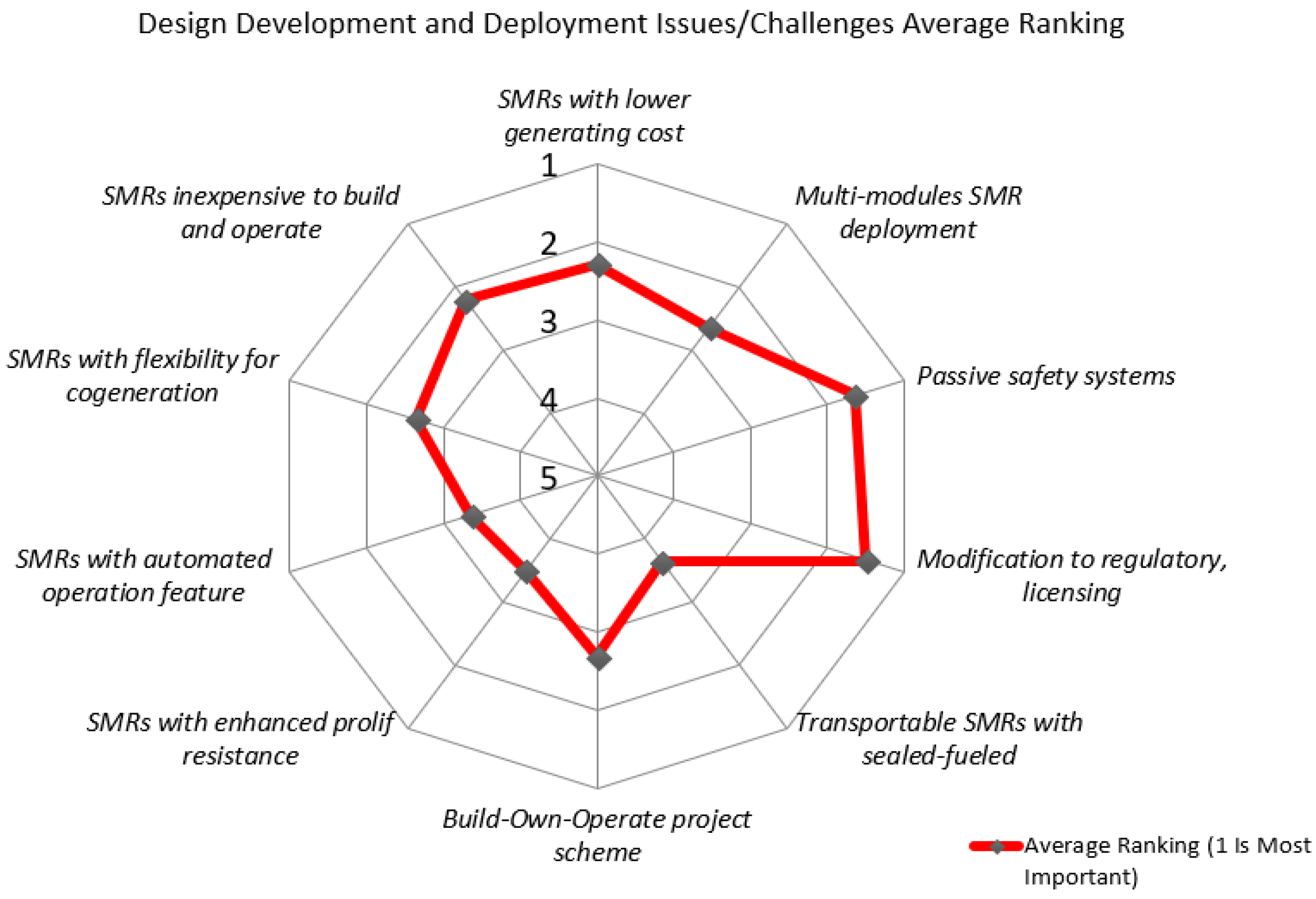
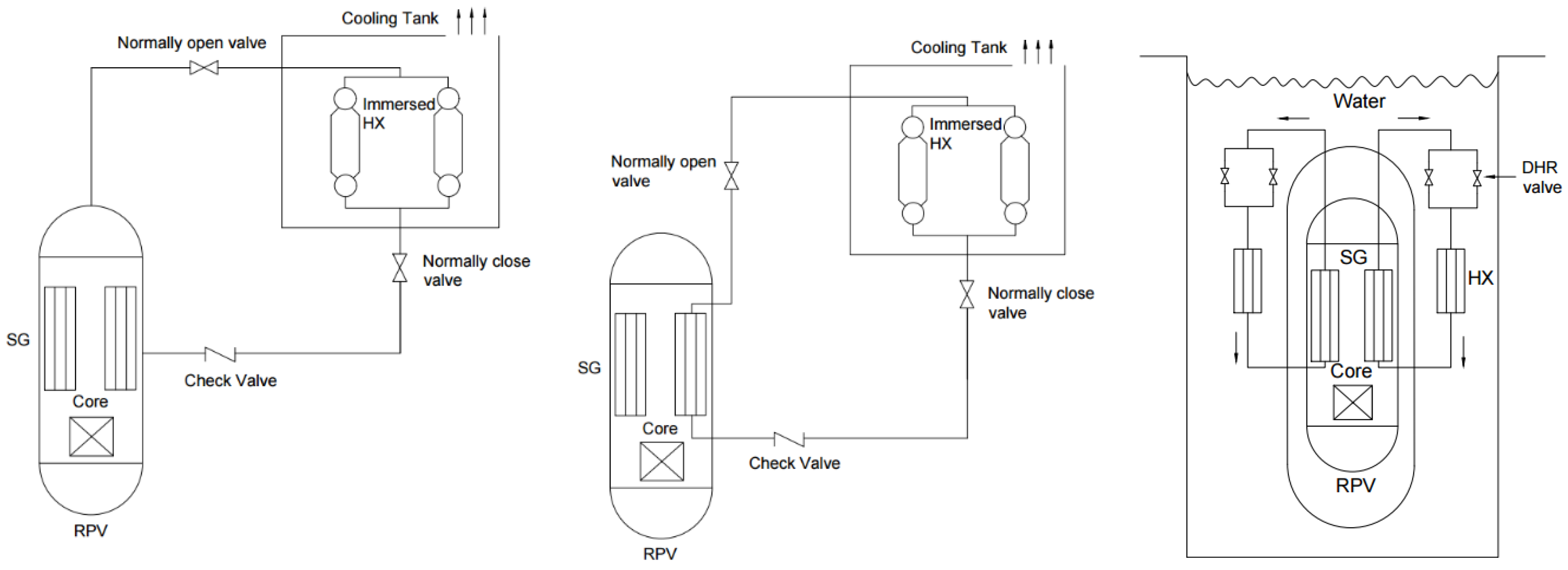
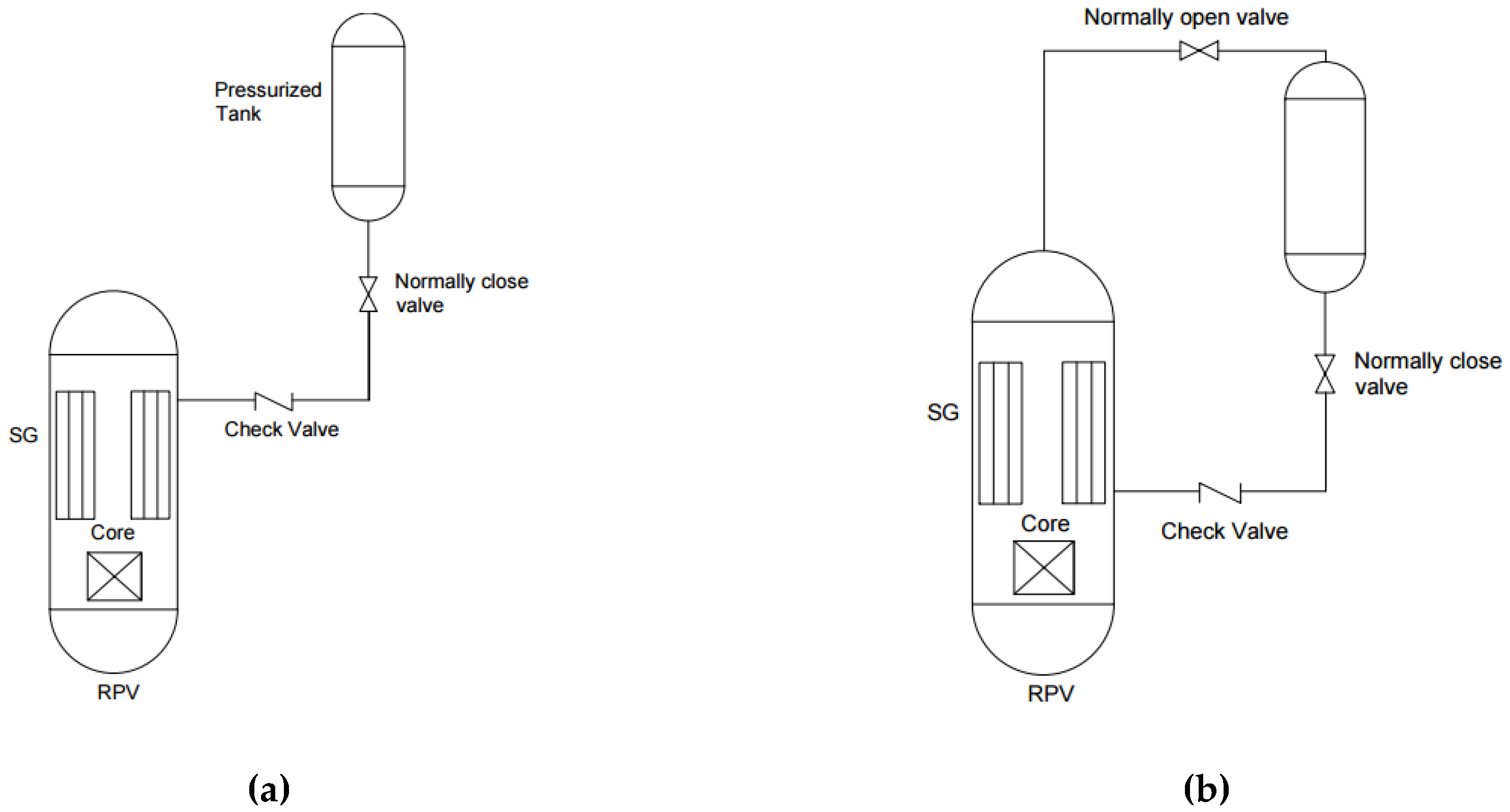
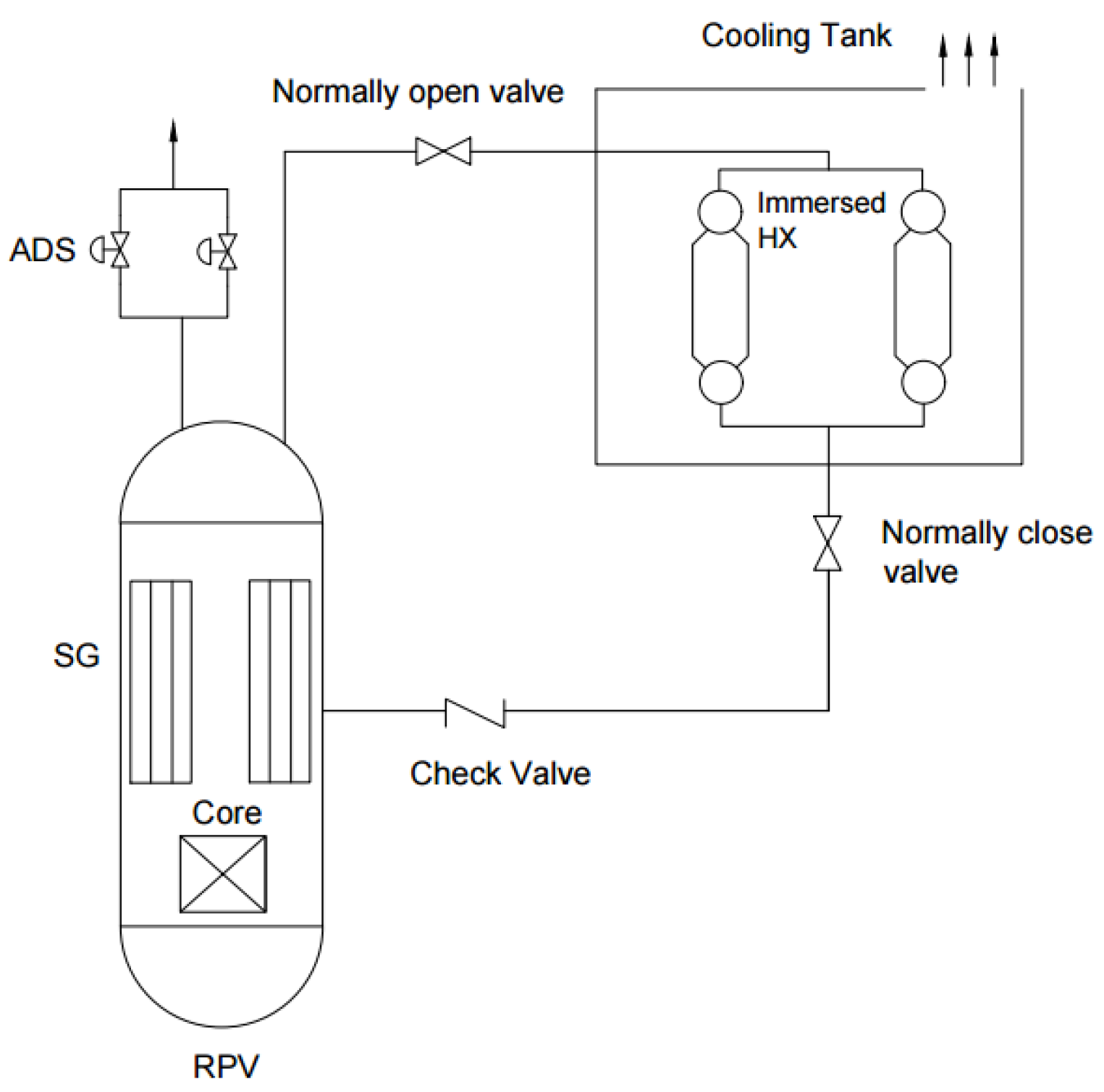
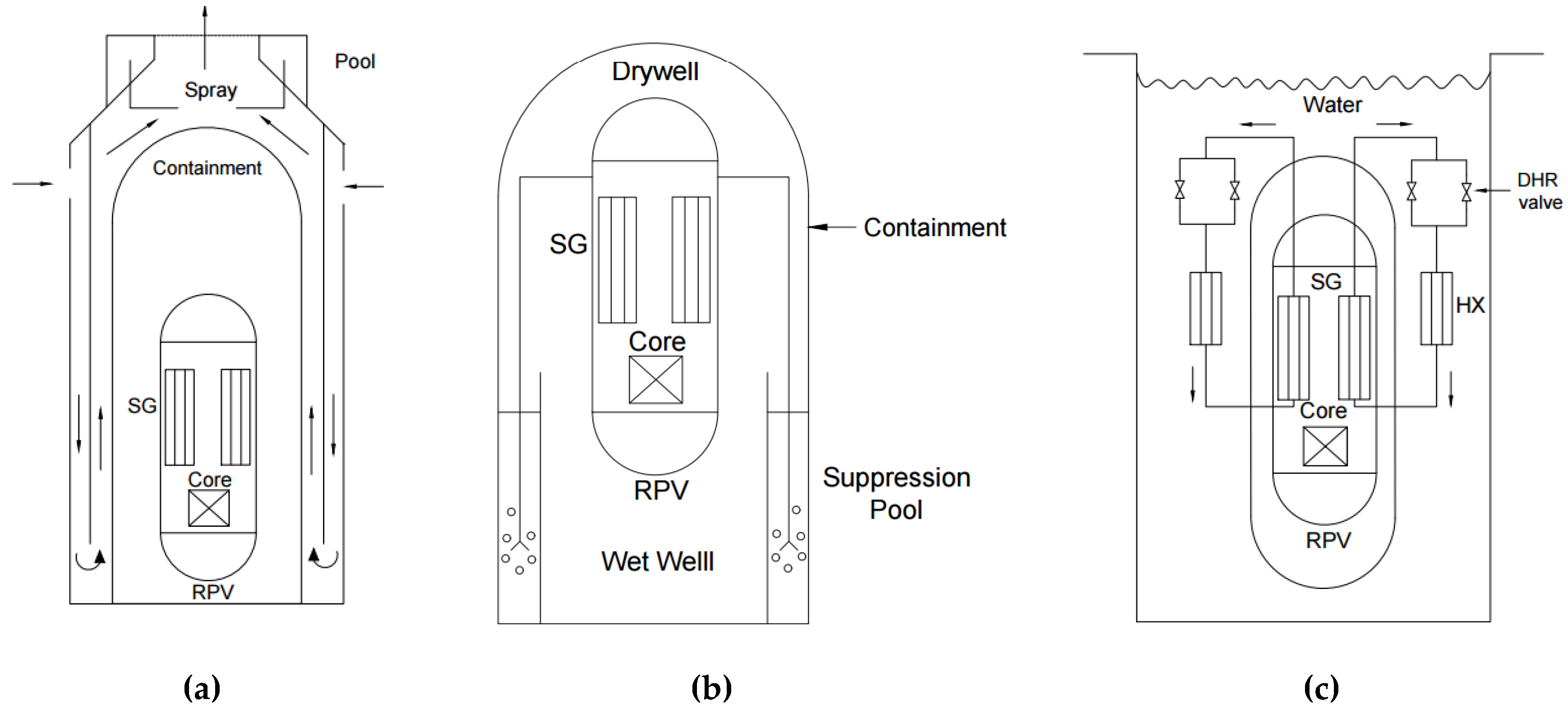
| Technology Developer | Reactor Design | Design Status |
|---|---|---|
| China National Nuclear Corporation (CNNC) | ACP100 | Under development |
| Shanghai Nuclear Engineering Research and Design Institute (SNERDI) | CAP150 | Conceptual design completed |
| Argentina’s National Atomic Energy Commission (CNEA) | CAREM25 | Under construction |
| Mitsubishi Heavy Industries, Ltd | Integrated Modular Water Reactor (IMR) | Conceptual design completed |
| International Consortium | International Reactor Innovative and Secure (IRIS) | Basic design |
| BWXT mPower, Inc. | mPower | Under development |
| NuScale Power, LLC | NuScale | Licensing stage |
| OKBM Afrikantov | RITM-200 | Under construction |
| Korea Atomic Energy Research Institute (KAERI) | System-integrated Modular Advanced ReacTor (SMART) | Licensed |
| OKBM Afrikanto | VBER | Licensing stage |
| Westinghouse Electric Company LLC | Westinghouse SMR | Conceptual design completed |
| Design Features | Advantages |
|---|---|
| Design simplification and relatively less complexity than active systems | Less maintainance; economic competiveness |
| System operates on natural physical laws or forces, e.g., gravity | No external power source required; eliminates loss of power accident; reduced dependent failures such as common cause; better impact on public acceptability |
| Minimized active system components | High system reliability; enhanced safety |
| Passive nature of PSSs | Eliminate/reduce reliance on operator action |
| Eliminate/reduced reliance on operator action | Reduced human error; improved human reliability due to the exclusion/reduction of operator error in the analysis |
| Design Characteristics | Facilitates for PSSs Start-up/Operation |
|---|---|
| Integral RCS design- reduced accident initiators | Minimized accident initiators to cope with/mitigate using PSS, resulting to a simplified design [14,46,51] |
| Lower core power capacity | Lower decay heat to be removed [51] |
| Larger surface to volume rati | Facilitates easier decay heat removal due to large surface area particularly for single phase flow |
| Larger primary coolant inventory per MW(th) | Larger heat sink for natural circulation; higher buoyancy force; reduced requirements for heat removal systems; slow transient and accident progression [12] |
| Less reactor core power density | Larger thermal-hydraulics margin; facilitates long term decay heat removal using PSSs |
| Large secondary coolant inventory | Facilitates passive decay heat removal and containment cooling [32], e.g., NuScale |
| Taller reactor pressure vessel | Facilitate for decay heat removal via natural circulation, i.e., higher elevation difference between heat source and sink and increased coolant inventory [52] |
| Smaller radial core and pressure vessel | A shorter distance from the core centerline to the reactor vessel, thus allowing better radial coupling of the decay heat from the reactor core to the vessel [13] |
| SMR Designs | Passive Safety Systems | ||||
|---|---|---|---|---|---|
| PRHRS | PSIS | PDS | PCCS | ||
| CAREM25 [23,41] | Number of trains | 2 train (RPV side) | 2 accumulators | 3 ADS + 2 train ICS | Pressure-suppression type |
| System components | Parallel horizontal U-tubes (condensers), water storage tank, and inlet-outlet valves and connecting pipes to the RPV | Borated water accumulators (ACC), injection line, and associated valves and piping | ADS: safety relief valves with 100% capacity each ICS: Same as PRHRS | Drywell, and wet well (suppression pool and gas compression chamber) | |
| Mission time (hours) | 36 | 48 | NA | 72 | |
| SMART [39,40] | Number of trains | Four (4) trains with 33.3% capacity each (secondary side) | Four (4) trains with 33% capacity each (CMTs + SITs) | ADS: Two (2) trains with two (2) stages each | Containment pressure and radioactivity suppression system (CPRSS) |
| System components | Emergency cool down tank, HXs, and make-up tank, check and isolation valves and instrumentation | Pressurized coolant tanks, pressure balance and safety injection line, isolation valves and associated piping | Automatic depressurization valves, vent lines, sparger, piping and IRWST | CPRSS lid, HX, IRWST, and IRWST vent line, pressure relief line, sparger, lower and upper containment area | |
| Mission time (hours) | 72 | 72 | NA | 72 | |
| NuScale [32] | Number of trains | 2 trains with 100% capacity each (secondary side) | 2 trains with 100% capacity each | 2 trains with 100% capacity each | A CNV immersed in reactor pool |
| System components | Two condensers in reactor pool, SGs, and actuation valves | Reactor vent valves (RVVs), and reactor re-circulation valves (RRVs) | Reactor vent valves and associated piping | RVVs, RRVs, RPV, CNV, and the reactor pool | |
| Mission time | 72 h | 72 h | NA | 72 h, and thereby air cooled after 30 days | |
| ACP100 [11,17] | Number of trains | 2 trains (secondary side) | 2 trains CMT + 2 ACCs + 2 trains IRWST injection | ADS: two (2) trains with three (3) stages | Air cooled with 2 trains + gravity drain lines |
| System components | Immersed HXs, IRWST, and associated valves, piping and instrumentation | CMT: pressurized coolant tanks, pressure balance line, isolation valves and associated piping ACC: similar to CAREM25 IRWST: storage tank, injection lines and associated valves | Automatic depressurization valves IRWST, and piping | Cylindrical steel containment vessel, containment cooling tank, air baffle, associated piping and valves | |
| Mission time (hours) | 72 | 72 | NA | Not specified | |
| mPower [31] | Number of trains | 2 trains (secondary side) | 1 train one-time injection + 2 trains NC based via IRWST | 4 low + 4 high pressure depressurization paths | Natural convection inside the containment + conduction heat transfer to passive containment cooling tank |
| System components | An auxiliary steam condenser, cooling tank, and associated valves | One time: nitrogen pressurized ACC, injection line and associated valves NC based: IRWST, direct vessel injection line and associated valves | Depressurization valves and piping | An integral water tank at the top of the containment in direct contact with containment dome structures that facilitates the heat transfer | |
| Mission time | 72 h | 7 days | NA | Beyond 72 h | |
| CAP150 [20] | Number of trains | 2 trains with 100% capacity each (secondary side) | Low pressure injection system | Eliminated by design | Steel containment submerged in containment pool |
| System components | Immersed HXs, IRWST, isolation valves and associated piping | Refueling water tank, auxiliary depressurization system and associated valves and piping | Containment water pool, RPV and supplement pool | ||
| Mission time | Not specified | Not specified | 7 days | ||
| IRIS [27] | Number of trains | 4 trains (secondary side) | 2 trains (at system pressure) | 4 train EHRS + 2 trains ADS with one (1) stage | Pressure-suppression type |
| System components | Emergency heat removal system (EHRS): horizontal U-tube HX, RWST, SG, SG make-up tank, connecting pipes and valves | Emergency boration tank, direct vessel injection line, redundant valves, and associated piping | Automatic depressurization valves, suppression pool, sparger, and piping | Six (6) water tanks, a common tank for non-condensable gas storage, vent pipe and sparger | |
| Mission time | 72 h | Not specified | 72 h | Not specified | |
| IMR [6,25] | Number of trains | 2 trains (secondary side) | Eliminated by design | ||
| System components | Passive SGs cooler in vapor and water, SG cooling tanks, exhaust and intake vent for air cooling, and associated valves and piping | ||||
| Mission time | Unlimited time | ||||
| W-SMR [43,45] | Number of trains | 4 trains (primary side) via direct vessel injection (DVI) +2 trains (secondary side) via steam drum | 4 trains of CMTs (high pressure) and 2 trains of ICP injection (low pressure) | 4 trains of ADS (4 stages) + 2 trains of PORVs above the steam drum | Containment vessel submerged in containment pool + 2 in-containment pool (ICP) |
| System components | Primary side: CMT, HXs, DVI line, ultimate heat sink (UHS), CMT pressure balance line, and associated valve Secondary side: SG, steam drum, and associated valves and piping | System pressurized borated tank, DVI lines, and associated valves and piping ICP injection: containment sump, ICP tank, sump injection line and check valves | Valves attached at the line of CMT, valves at the top of the ICP tanks and valves into the RPV | Steel containment vessel, containment pool (outside), UHS, and valves connecting the containment pool with the UHS | |
| Mission time | 72 h | 72 h | NA | 7 days | |
| RITM-200 [20] | Number of trains | 2 passive trains (secondary side) + 2 active trains | 2 passive trains + 2 active trains (one-time injection) | Not specified, but similar to KLT-40S | 2 trains |
| System components | Passive: DHRS tank, a HX immersed in DHRS tank, a water storage tank and air cooled HX | Passive: pressurized hydraulic accumulators, injection line, and associated valves | Not specified, but similar to KLT-40S | HXs in and outside the containment, storage tank and associated valves | |
| Mission time | 72 h | 72 h | NA | Not specified | |
| VBER-300 [25,42] | Number of trains | 2 trains (secondary side) | 2 trains (2 stages ACCs) | 2 trains | 2 trains |
| System components | Passive in-built HXs, water tank and a process condenser | Parallel hydraulic ACCs, injection line, and associated valves | Conventional SRVs at the top of the pressurizer | HX immersed in water storage tank, HX inside the containment, and associated valves and piping | |
| Mission time (hours) | 72 | 24 | NA | Not specified | |
© 2020 by the authors. Licensee MDPI, Basel, Switzerland. This article is an open access article distributed under the terms and conditions of the Creative Commons Attribution (CC BY) license (http://creativecommons.org/licenses/by/4.0/).
Share and Cite
Zeliang, C.; Mi, Y.; Tokuhiro, A.; Lu, L.; Rezvoi, A. Integral PWR-Type Small Modular Reactor Developmental Status, Design Characteristics and Passive Features: A Review. Energies 2020, 13, 2898. https://doi.org/10.3390/en13112898
Zeliang C, Mi Y, Tokuhiro A, Lu L, Rezvoi A. Integral PWR-Type Small Modular Reactor Developmental Status, Design Characteristics and Passive Features: A Review. Energies. 2020; 13(11):2898. https://doi.org/10.3390/en13112898
Chicago/Turabian StyleZeliang, Chireuding, Yi Mi, Akira Tokuhiro, Lixuan Lu, and Aleksey Rezvoi. 2020. "Integral PWR-Type Small Modular Reactor Developmental Status, Design Characteristics and Passive Features: A Review" Energies 13, no. 11: 2898. https://doi.org/10.3390/en13112898
APA StyleZeliang, C., Mi, Y., Tokuhiro, A., Lu, L., & Rezvoi, A. (2020). Integral PWR-Type Small Modular Reactor Developmental Status, Design Characteristics and Passive Features: A Review. Energies, 13(11), 2898. https://doi.org/10.3390/en13112898







